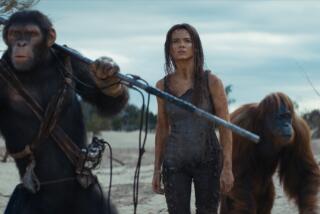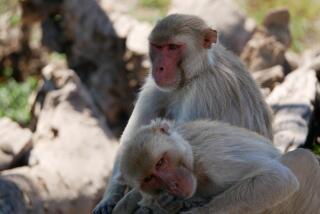1989 Book Prize Winner: Science and Technology : Peace: A Biological Imperative for Primates?
- Share via
In “Peacemaking Among Primates,” Frans de Waal calls attention to an important but recently overlooked perspective in ethology, the study of the evolution of behavior. A relatively new science, ethology incorporates theories of behavior that go back at least 200 years, when scientists first looked to the natural world for a blueprint of the social contract, the basis for human behavior. Since then, they have moved from the picture of man as a “noble savage,” born into an Eden and then corrupted, to the post-Darwinian vision of man as another animal subject to fierce competition for limited resources in order to survive.
On a January day in 1880, a different view came to the attention of Peter Kropotkin, known historically as the ideologue of anarchism, when he heard about a lecture presented at the Russian Congress of Naturalists by a well-known zoologist, who suggested that besides the law of mutual struggle--species locked in a gladiatorial battle for existence--there was a corresponding and even more important law of mutual aid. Three years later, Kropotkin read the same suggestion in Darwin’s “The Descent of Man” and set to work collecting data, which he published, in 1902, as “Mutual Aid,” a chronicle of cooperative behavior in the progressive evolution of the species.
Kropotkin reissued “Mutual Aid” in 1915 in order to set the record straight. He insisted that the war then destroying civilization as he knew it was not inevitable. People cooperate even under siege, he argued: Witness the peasant women who thrust bread and apples into the hands of German and Austrian prisoners as they trudged through the streets of Kiev. Mutual aid, he asserted, is a necessary correlative of competition among social animals, including human beings.
But this optimistic view of nature did not win much favor as the 20th Century continued with wars and genocide expanded to levels previously unimagined. Biologists and ethologists, along with psychologists and sociologists, sought the roots of this violence in the evolutionary past.
The roots were not hard to find. Violence is dramatic and easy to document. Tracking hostile behaviors in other species fulfilled the expectations of those who read these acts as a genetic necessity, a selection of evolution. However, while aggression is a successful adaptation among other species, it becomes a fatal flaw in humans who still react instinctively, hair standing on end, adrenaline flowing, to hostile movements, responding with nuclear weapons instead of sharpened canines.
The late Konrad Lorenz, an Austrian ethologist of enormous stature, observed that an animal must be aggressive to compete successfully, and he reasoned that aggression has biological roots. This concept, which he explored in “On Aggression,” published in English in 1966, inspired a generation of scientists. Perhaps as an effort to universalize the atrocities of the war he had lived through in Germany, Lorenz defined aggression as the starting point of all social relationships. Aggression inspires hierarchy, community, and among non-human species controls the dispersion of resources. But among humans, he asserted, it is out of control. As a species we have run amok because we do not have the inhibition to control our aggressive instinct.
Lorenz’s work was followed by a spate of books and articles testifying to the biological, hormonal and psychological basis of aggression in human beings. The consensus seemed to be that we come equipped with a runaway instinct, one that suited our ancestors on the savannah, but in the world of advanced weaponry seems to doom us to extinction.
Awash in this news about the aggressive nature of animals in general and primates in particular, ethologists such as Jane Goodall and Dian Fossey began to document intra-species killings, even cannibalism, among those apes we had all learned to love because of their gentle nature.
De Waal rejects this pessimistic and one-sided picture of the human predicament. “Peacemaking Among Primates” can be seen as a delayed, and infinitely more sophisticated, sequel to Kropotkin’s attempt to describe with scientific accuracy the centripetal forces that keep societies together as well as the centrifugal ones that drive them apart. It also is an elucidation and expansion of Lorenz’s views, accepting the reality of aggression but positing it as only one side of the coin.
De Waal is both a revisionist and an optimist. Indeed, he concedes that primates fight. But at least as often they avoid clashes that could lead to fights; and when they do fight, they make peace with their adversaries so that the community continues as before. He documents this assertion with detailed studies of five primate groups including chimpanzees, macaques and human beings, using data he has meticulously collected over more than a decade. He confirms in the idiom of a modern ethologist what Kropotkin could only surmise: that mutual aid has enabled primates to evolve complex and viable social groups.
De Waal demonstrates that science can be like poetry: Once a truth is stated, our vision shifts and we cannot imagine how we did not see it before. We join De Waal in the public observation post at Arnhem Zoo in The Netherlands, above the largest colony of chimpanzees in captivity. De Waal knows each individual by name and personality (and has already written about them in an earlier book, “Chimpanzee Politics”). Familiar with their frequent fights, he realized in a moment of inspiration that their conflicts always ended in reconciliations that left most relationships repaired and normalized. Along with his colleagues, he had been blind for years to what had been happening before their eyes. Thus he began to study the nature of reconciliation, of peacemaking among these chimpanzees.
From the chimps at Arnhem, he went on to study peacemaking among rhesus and stump-tailed macaques at the Wisconsin Regional Primate Research Center where he is now a research scientist; among bonobos (pygmy chimpanzees), in the unique group at the San Diego Zoo; and among human beings. He discovered similar patterns of peacemaking among the five groups of primates. He also discovered a blindness among other scientists to the study of peacemaking. He describes a world- renowned psychologist, a specialist in human aggression, who grew irritated at the suggestion that evolution has anything to do with explaining behavior, and had not even considered the possibility that conflicts are inevitable among people because aggression has a long evolutionary history, and that reconciliation is worth studying because it is logical to expect the co-evolution of powerful coping mechanisms.
Perhaps that psychologist will read his book. The evidence is overwhelming that we share with other primates the mechanisms for fighting, but also the need for friendship, support, body contact and even sexual activity as a social function, and to get these we, too, have evolved mechanisms for face-saving, for compromise, for consolation and for reconciliation.
Until now--and this is the heart of his message--most scientists have believed that violence is more integral to human nature than peace. In reality, he demonstrates, we have highly developed strategies for consolation and reconciliation.
De Waal brings a new perspective to a discipline that has been dominated in the English-speaking world by self-consciously detached observers as well as by those who see animals as a gene’s device to reproduce itself. De Waal also rejects the approach that science starts with a battery of hypotheses which are dispassionately tested. He points out that Darwin didn’t set sail to test a theory. Rather, he returned with the ingredients to make one.
Theory never takes precedence over his personal observations, one of which led him to reject the extrapolation of the famous crowded-rat experiment to the human condition. In this experiment, caged rats that were pushed closer and closer together eventually went mad and turned cannibal. But De Waal notes that vervet monkeys crowded together simply avoid eye contact and look at the sky and ground a lot. The same could be said for his countrymen who, while living in one of the most densely packed nations on earth, enjoy low crime rates and a high degree of personal tolerance. Primates are one thing, rats another.
As a Dutchman, de Waal also is especially careful about English, the way a person must be whose native language is not the lingua franca of any major discipline. He distinguishes carefully between the words “aggression” and “violence,” the latter being the most extreme but not the most common form of the former. He also distinguishes between “consolation,” the act of support by a bystander to the victim of a hostile encounter, and “reconciliation,” peacemaking between the actors in the encounter.
De Waal’s observations are wide-ranging, surprising and invariably provocative. With increased knowledge of primate behavior, he worries about the ways some zoos isolate these highly social creatures. From observations that male primates participate in acts of reconciliation more frequently than do females, he wonders if males are generally more conciliatory than females, and speculates on the differences between the sexes in our own species.
This gracefully written book is unabashedly political, referring frequently to contemporary issues to make a point. Concerned about survival, De Waal in 1986 signed the Seville Statement which asserted that “Biology does not condemn humanity to war.” But unlike the other signatories, who felt that we could rise above our biological destiny (through intelligence, one supposes, and restraint), De Waal believes it is that very biological heritage that provides us with the mechanisms of reconciliation which he urges us to develop. We are creatures of evolution, and have arrived where we are because we are able to control and channel our aggressions. Peacemaking is not only desirable, it is, in a sense, evolutionarily prescribed.
Science And Technology Nominees Is Science Necessary? Essays on Science & Scientists by Max F. Perutz (Dutton) The Five Senses by F. Gonzalez-Crussi (Harcourt Brace Jovanovich Peacemaking Among Primates by Frans de Waal (Harvard University Press) Science As A Process: An Evolutionary Account of the Social and Conceptual Development of Science by David Hall (University of Chicago Press) What Mad Pursuit: A Personal View of Scientific Discovery by Francis Crick (Basic Books)






